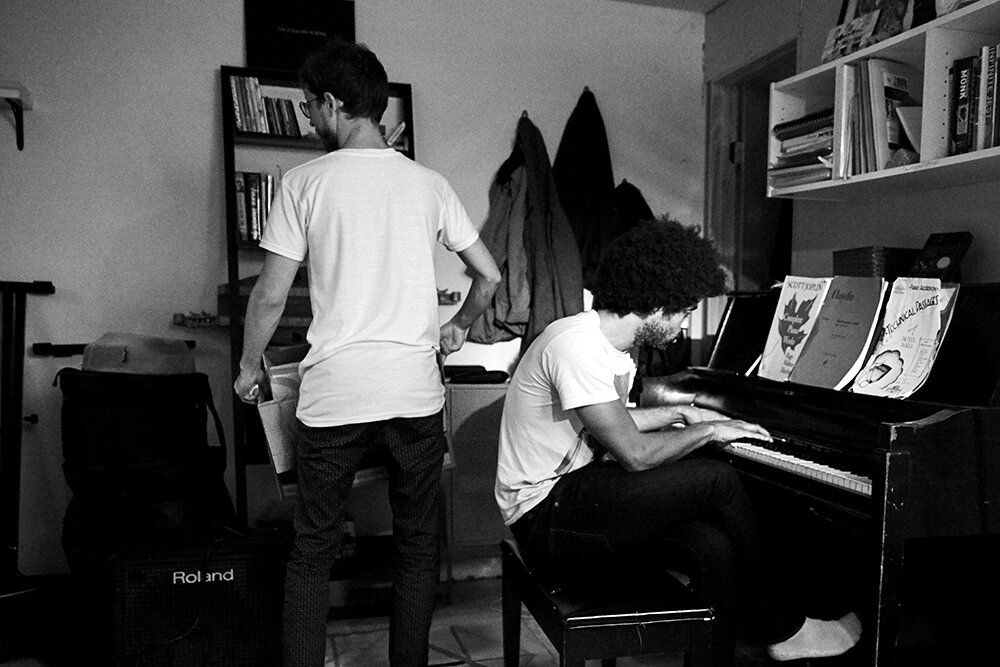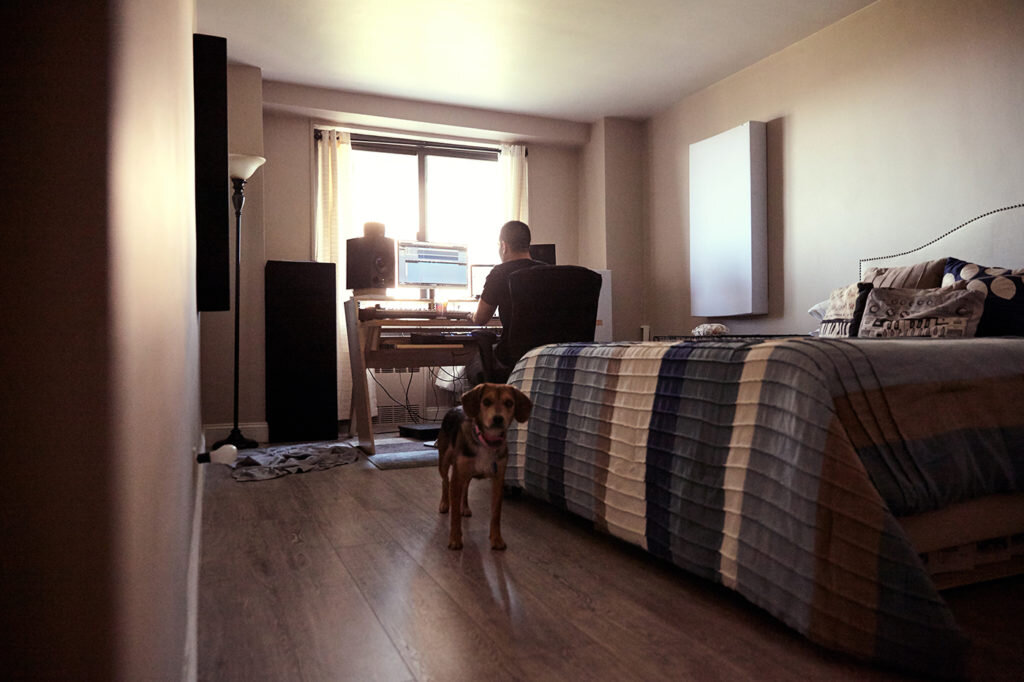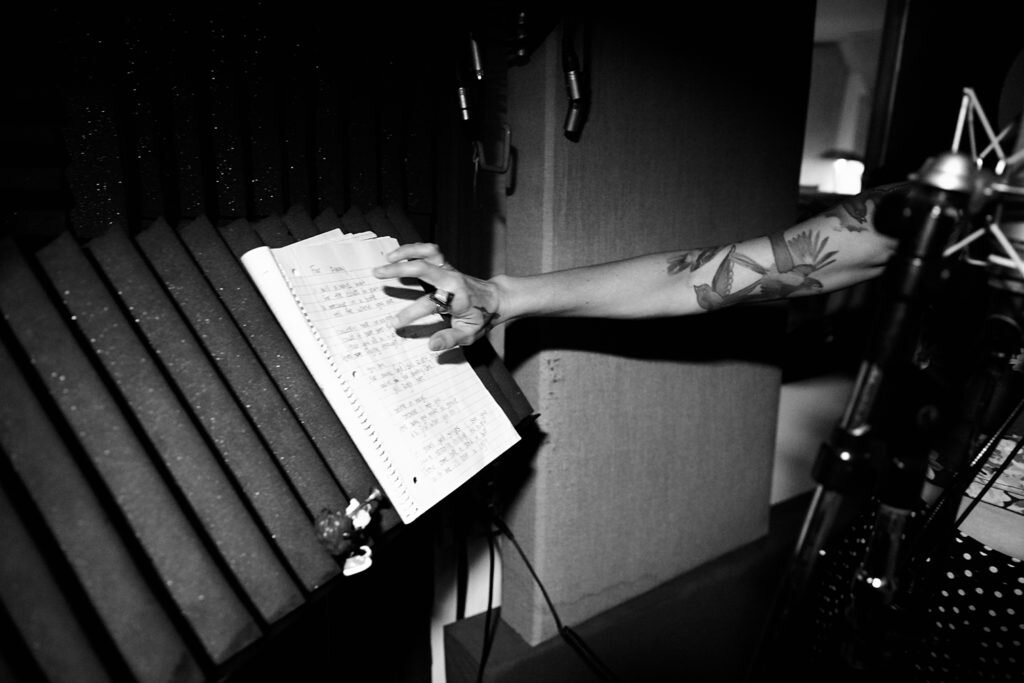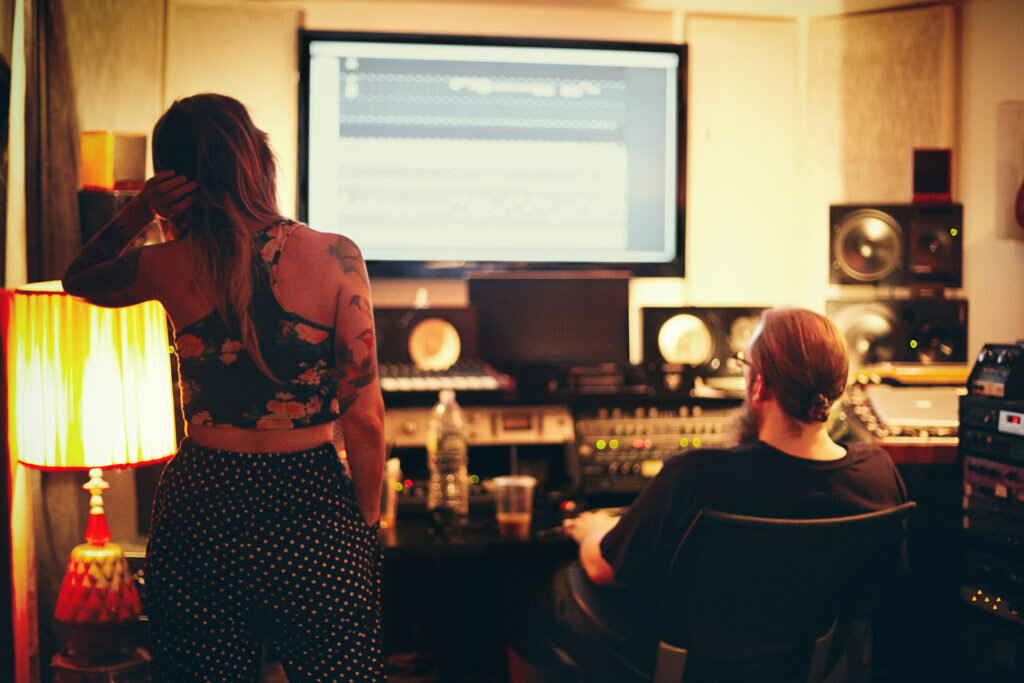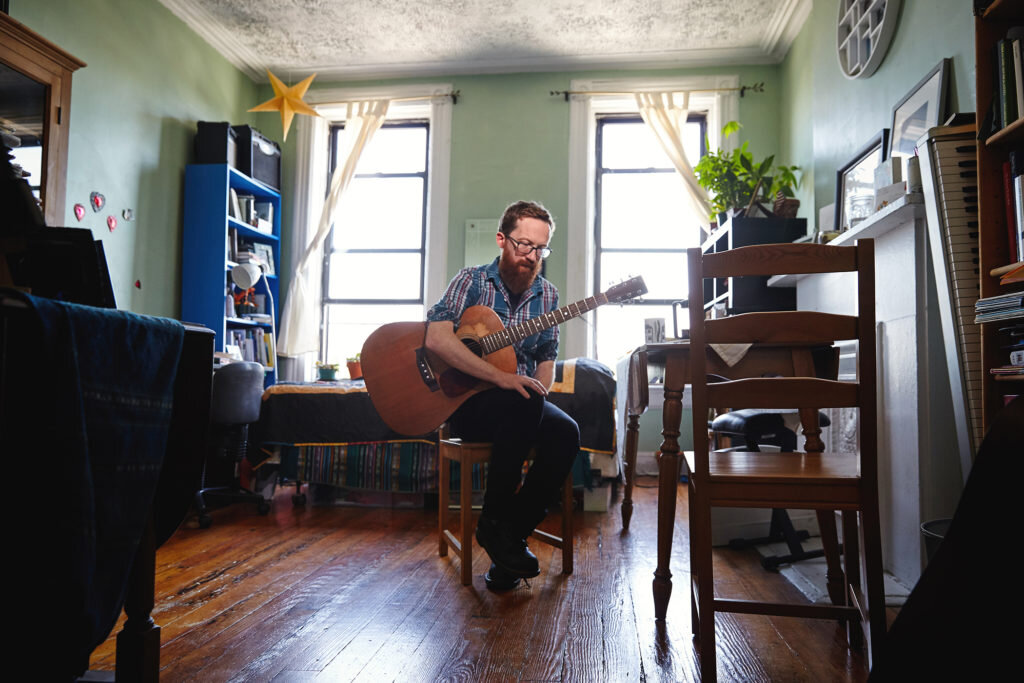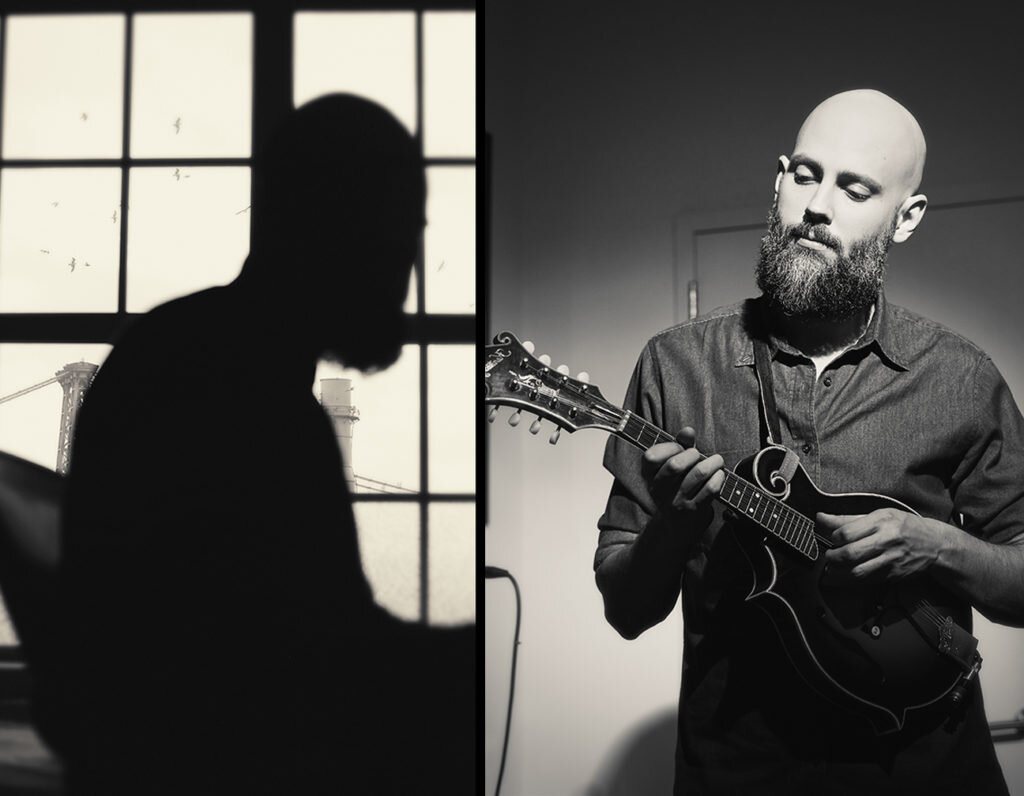Josch Chodakowsky’s Library of Sounds and Inspiration
I'll be honest, I have never thought about the term nor the concept of ethnomusicology until I photographed Josch Chodakowsky in his apartment in Ditmas Park a few months ago. Josch (aka DJ Inbetween) is a DJ and composer- more specifically a sound collage-r, creating music by sampling elements from written songs to create completely unique songs. Josch's living room contains a library of about 10,000+ records, spanning the decades and continents. He has always had a fascination with the history of music and began collecting records at a young age. It should come as no surprise that Josch's educational background is in Library Science and aside from composing and DJing, he works as a researcher during the day. But his true love of DJ'ing began while he was still in school, circa mid-1990s, when he and his friends would gather to listen to the latest hip hop records and attempt to sample their first songs.
Facing the giant wall of records, I couldn't help but feel overwhelmed. Where would you even start when you have a universe of sounds at your disposal? When I asked Josch, he said for himthe creative process is a bit like "lightning in a bottle". He began pulling records out to show me how ideas would turn into songs, picking out a bass line here or the first measure off of another record, and programming those so that a song began to emerge. Most of the samples were completely unrecognizable and he purposefully choses songs that are obscure so that the listener doesn't form associations with that sound. Each time he pulled a record, on to the turntable it went, quickly and without hesitation. Then, when the piece he wanted to play was over, back into the library they went, sometimes to a different spot than where they came from - a reflection of the organization that only he was privy to. It reminded me a bit of a cook in the kitchen, grabbing a pinch of this spice and that, stirring around and tasting the sauce to see what else was missing.
Within the confines of the concept of musicianship, what Josch creates might not be considered making music because he's not actually playing or composing with an instrument. However, to me, it absolutely embodies the term. To create a unique song by connecting dozens or hundreds of already written elements of music, is still in its essence composition and it is incredible to see these stretches of creativity and the capabilities of sound. A postmodernist approach to making music, and one that weaves together society and culture at that moment in time.
For Josch, collecting records is a bit like archeology; an examination of the significance of music in our culture and the tracing of the roots of modern music to their points of inspiration. His appreciation of music is infused with an innate curiosity of piecing a puzzle together that is in fact never ending. When he hears something that strikes him, for example an interesting bass line, he will often look up the musician, find the other records they played on, research what influences they had, and then delve into the music of those influencers, and so on and so on until a musical family tree of inspiration begins to emerge.
Although Josch's musical inclination is towards early Funk, Soul and Hip Hop, his research extends far across the globe. He told me he would go through phases when he would delve into a certain country's music and dig deep into their history, often piecing the significance of the artist in that country's moment in time. And often, when he embarks on a particular country's music history, he learns how to play the musical instruments native to the country so that he has a deeper sense of the music.
When it comes to record collecting, the rarer the record, the more exciting. "If the apartment was on fire, this is the box I would take with me" he said as he pulled out a "Supercase" of 45's. Gently he took out a record by The Third Guitar with "Baby Don't Cry" on it and laid it on the turntable. In the process, showing me the tattoos on his forearms which replicated the album's label. What made these particular records so sought after? Josch explained that some of the records in the Supercase were rare because they were the original albums that had been sampled by famous songs, in other cases, they were records made by unknown bands of which there were only a limited number of copies pressed. I asked him why it would be matter if a completely unknown band had put out a limited number of records. But he explained that for collectors, the thrill is in finding that incredible and undiscovered record from an unknown band. A stroke of luck and/or determined investigation.
Explore Josch Chodawsky’s music: Facebook: https://www.facebook.com/joschchodakowsky Mixcloud: Www.mixcloud.com/djinbetween Soundcloud: https://soundcloud.com/dj-inbetween IG: @djinbetween
Trumpeter Wayne Tucker in his Crown Heights creative space
A few months ago, I had the pleasure to photograph trumpeter Wayne Tucker in his Crown Heights apartment that he shares with four other musicians. We began by talking in his living room. There in the middle of the room, Wayne conducts his daily practice, a combination of meditative breathing and trumpet playing. Closing his eyes, he counts to 10 in his head and clears his mind of everything except the even nature of his breath. He holds each note as long as possible while trying to maintain the same intensity. This practice allows him to channel all of his energy into his playing, a technique he later uses when he's onstage. When performing, he listens to the energy of the room and tries to concentrate on it, focuses all his effort on the energy coming out of him and into the audience.
Wayne comes from a family of musicians; his father, a piano player, was the main influencer of his musical taste, exposing him to funk, soul and r&b from an early age. Naturally, Wayne's first instrument was the piano, then he learned to play the violin, and finally the trumpet. His older brother (who is one of the four musicians he currently shares an apartment with), plays the tenor sax. In fact, it was after his brother began playing the saxophone, that Wayne picked up the trumpet. He grew up with a built in band at home, often jamming and experimenting from a young age.
Wayne spent a long time studying the technicalities and the math behind the music, including the patterns and permutations, to the point that it can become instinctual, allowing him to focus on evoking the feeling behind the music. In high school, he was part of an orchestra, which allowed him to understand composition and gave him an ability to hear all the elements in a song. That experience fueled his musical passion, the search for beautiful harmonies.
His latest album "Wake Up and See the Sun" (released this September), is about appreciating what one has in life. He is drawn to using music as a vehicle to transport the listener to a specific place or feeling. A way to share his world with others. Many of the songs on the record had been written years ago, but he wanted to take the opportunity to explore them musically, incorporating different instrumentations and sounds to create an eclectic sound quilt for the listener.
When I asked Wayne how he composes songs, he shared that it always starts with the piano, and as the song builds, he finds the natural moments where the trumpet can come in. So we went downstairs, to his roommate's (David Linard) room where there is a stand up piano. While his roommate was packing to go to rehearsal, Wayne started fiddling with the keys, experimenting with a progression of notes he played over and over. I asked him what he was thinking of as he was doing this, and he said it reminded him of being in church. The first time the pastor says "Jesus" it doesn't really have much of an effect on you, but slowly as he repeats the name over and over, the word starts to take on a meaning. So do the progression of notes as he plays them over and over, until a melody begins to emerge...
Explore Wayne Tucker's music: Facebook: https://www.facebook.com/wayne.tucker.73 Spotify: Spotify IG: @wayneeverest
Inside the creative space of Progressive Trance artist, Jack Barrile aka Blugazer
When you have an unlimited number of sounds and places to start composing, where do you begin? At least with an instrument you are limited to a range, chord structures, tonality, but with electronica music, you have an entire universe of sounds at your disposal. To me, it's as intimidating as the empty page for a writer, sitting in front of a typewriter waiting for the first sentence to come. When I asked Progressive Trance artist, Jack Barrile, about it, he said it was those same endless possibilities that drew him to electronica music in the first place. As the first electronica artist to be featured in the series, I wanted to find out more about how his creative process is defined by the genre. Jack began producing music in 2006, and stated putting it out into the world in 2010 under the alias Blugazer. To him, music is an exploration and an interpretation of how he sees the world, an expression of his reality and his dreams. When I came to photograph him in his creative space (his apartment in Clinton Hill), we walked to his bedroom where his setup was and he began working on a new idea. He shared that he had recently been to the beach during his trip to Florida and he was inspired by the divergent experiences of the beach by day vs the beach by night. He began composing two songs, one a counterpoint to the other.
Jack always begins with a concept, an idea of a feeling, a mood, a place. He is also very cognizant of his own sound; he's drawn to dreamy, atmospheric, spacial sounds that are warm, dark, and mysterious. Knowing what he likes to hear is what helps him know where he wants to take a song and its elements. Although he did not go to school for music, he studied it on his own, researching music theory and composition, chord structures and production concepts, using the knowledge to push his production further. He mentioned that he wasn't sure if he can really call himself a musician, because although he knows how to play various instruments, he doesn't really play any one in particular. He is in essence a composer, putting together musical elements and sounds to create a soundscape.
By day, Jack works as a software engineer, but he wakes up every morning two hours before the start of his day to work on his music. Before leaving his house, he exports whatever he worked on that morning and listens to it throughout his work day, dissecting and finessing the song in his head. Often he comes home at 7pm or 8pm and dedicates another two hours to music, either practicing and teaching himself musical theory, or working on the song he began that morning. And he does this every day.
Jack's creative process follows a very unique and analytical workflow that he has developed and refined over time. In some ways, the organized nature of his process feels like a reflection of his engineering work, he tackles each part of the song in a precise and stacked manner, starting with the drum and bass lines first and then building the song piece by piece until he has completed each portion of the structure. His workflow gives him parameters within which he can be creative and explorative, while still allowing him to complete each song without being dragged into the abyss of possibilities of sounds.
This idea of finishing a song is something he stressed is an incredibly important part of his creative process. Even if the elements are not there yet, even if he didn't find the right bass line, even if the song isn't good, he must finish it. Completing a song is necessary for building the muscle memory of how to do it so that when a good song comes along, you know how to finish it. He shared that he thinks one of the issues many artists have is completing songs, often spending a long time on one element that is not quite right or putting the song aside for later when a better idea might come along, and then never coming back to something that could be great. I know I have suffered the same thing in my own photography, often having a good concept for an image but perhaps not completing it in the postproduction phase because it wasn't working out the way I envisioned. I think Jack is right, there is a lot of value in working through something and forcing yourself to not get stuck, even if your initial passion for the idea has changed. You learn something in the process that you wouldn't have if you just gave up. At the same time, I can understand that in this life where we have a finite amount of time, it's hard to convince yourself to keep working on an idea when you don't feel as excited about it. But then again, if you're training for a marathon, you need to complete those long training runs, even if you sucked that day and your time was terrible, just finishing each one of those long runs helps you complete the marathon on race day. If creativity is a muscle, I think Jack is onto something.
Explore Jack Barrile's (aka Blugazer) music: Website: https://www.blugazer.com/ Soundcloud: https://soundcloud.com/blugazer FB: Blugazer
A creative collaboration in Brooklyn: Kendra Morris and Jeremy Page
One Thursday afternoon a few weeks ago, Kendra invited me to join her and her producer / co-writer, Jeremy Page, at his studio in Bushwick where they write and collaborate on music. I had photographed Kendra in her home (the place where many of her ideas originate) but this studio is an integral part of her creative process. She keeps dozens of journals with song ideas and lyrics (a habit she formed ever since she started journaling at the age of 13), and in these journals she often writes out ideas for a song, edits them, writes out new ones, and then copies over the refined song on a fresh page. She brings these ideas to Jeremy and, together with his help, they flesh out the music and create the soulful and sultry sound that she is known for.
When I asked Kendra how she started working with Jeremy, she shared that she came across his production from another musician (a friend and patron of the Library Bar where she used to work). When she heard his sound, she knew she wanted to work with him. And so she did. For the last 9 years, Kendra and Jeremy have kept a steady weekly writing session, finding in each other a perfect balance of sounds and artistic aesthetic. It is here in this studio, the basement apartment of a townhouse in Bushwick, that they truly get to create.
When I walked in, Kendra and Jeremy were in the process of tracking a newly written song that was dedicated to a good friend of theirs who had passed away suddenly. They had written the song over the course of a single session just two days after they found out about their friend's death. They had both cried as they wrote it.
Kendra walked inside the vocal booth and I followed. They were going to do a few runs so I knew I had some time to photograph before the camera shutter clicking had to stop. This was my first time inside the booth while someone was singing (for obvious reasons, most of the time you try to avoid extra sounds). I crammed myself into a corner, only 2 feet away from Kendra, and waited. She had headphones on but I couldn't hear the music. I could only hear the sound of her voice.
While Kendra is in the booth, Jeremy is behind the board, giving suggestions and guiding the takes until they know they have it. He has expertly arranged the song so that the process is seamless. It's a unique collaboration and one that I imagine is not very easy to find.
The thing about Kendra is that, when she sings, is she gives it her absolute freaking all. Her entire body is activated and she uses it to help convey the precise emotion needed in that part of the song. It's incredibly entrancing to watch and you can feel the energy flow from her core, through her hands and out of her voice.
How incredible to be a witness to the moment of creation! To see two artists interweave their craft and create beautiful music together. Loved every minute of it.
Explore Kendra Morris’s music: Website: Kendra Morris Spotify: Kendra Morris FB: Kendra Morris
Niall Connolly and a railroad apartment in Park Slope
Most songwriters I have come across know Niall Connolly and it's no surprise. He's been leading the Big City Folk Club for nearly 10 years, it's a song circle known for its excellent quality of musicianship and camaraderie. He's a dedicated and tireless member of the NYC music scene striving to create a community where musicians can bring their songs and open them up for other songwriters to hear and offer feedback. I asked him why he's been doing it all these years (after all, it's not an easy feat to organize these biweekly events especially when venues change and the sign up has to be done in advance), and he said that back in Cork (where he's from), you would go to parties and a guitar would be passed around, giving each person a chance to play a tune. There, the culture of music and an appreciation for sharing that music with others, created a community and an audience of friends and fellow musicians. When he moved to New York eleven years ago, he missed that community and wanted to build one here. And so he did, to great thanks from the musicians of this city!
Niall's creative space is his home, an apartment in Park Slope that he shares with his wife, Clare, an art teacher. It's a vast railroad style apartment that stretches the span of the building, with windows on both sides and high prewar ceilings. His writing spot is the desk in his bedroom. A corner where he sits down with a cup of coffee and a guitar in hand and works on his craft.
When I asked Niall about where his inspiration comes from, he said he used to write a lot from personal experiences but now, his creative process has changed. He's on the road a lot, touring by himself, and he finds the road gives him a lot of opportunities to listen. When he's traveling, he has the opportunity to meet new people and hear their stories. This is where he derives his inspiration from nowadays.
I am always curious about the types of stories a musician is most drawn to telling. As artists, songwriters, photographers, we all strive to tell human stories that make us feel - whether it's joy or sadness or an empathy for the human condition. Sometimes it seems like the darkness in humanity is the most powerful story to tell because its full of raw emotions. One of the beautiful things about Niall's music, is that despite the darkness, there is a glimmer of hope. A search for the belief that human beings can be better than their circumstances. Those are the stories that Niall tells so masterfully. In his songs, there is a message of urgency, to turn life around, to make it better because that is what the human condition demands of us. To keep going despite and in spite of it all.
Niall has this incredible line in one of his older songs which has stuck with me ever since I first heard it: "We are just skin and bones without love." And damn, what greater truth can be said?
Niall is releasing a new album this Friday called "DreamYour Way Out of This One" and has just begun his tour around Ireland. I hope he finds more beautiful tales on the road...
Explore Niall Connolly's music: Website: Niall Connolly Spotify: Niall Connolly FB: Niall Connolly Music
Scarlet Sails’ Artist Collective in Morningside Heights
A few months ago, I walked into Olya and Brian's (of the Scarlet Sails) house in Morningside Heights, a beautiful 5 story building, the kind you picture as being representative of old New York: a sweeping staircase leading up flights of stairs, a kitchen located on the 2nd floor, and bathrooms featuring that quintessential black and white New York tile. The story of the building itself was rather unusual, owned by Columbia University, the building was actually leased in the 70s to one of the university clubs (I believe it was a language club), and the woman who originally leased it has held on to the building despite Columbia University's attempts to retake it. Over the years, the building grew into the hub of an artist community, attracting artists, sculptors, musicians and other creatives. Although the house has had a rotating roster of artists, the apartment itself didn't become what it was until Brian moved in over 10 years ago and started carving out the main living room as a creative space, filling it with instruments and music.
Olya Viglione, is the main songwriter of the band, Scarlet Sails, and her husband, Brian Viglione, is the drummer and co-songwriter. It was so interesting to learn about their creative collaboration and witness the different ways they go about approaching new musical ideas. Often, Olya brings the initial lyrical or song idea to Brian who then fleshes out the structure and dynamics of the song. Olya is a Russian-conservatory trained pianist, who, after years of studying the classics, found that she couldn't stay within the confines of classical music, always gravitating to sounds that are very different, following unusual scales and chord patterns. When she talked about songwriting, she expressed thinking of the movements in terms of colors, finding a specific shade of color in the chords to convey the feeling.
Brian is the first drummer I shot in the Creative Spaces series, and I was curious to learn about what the process of songwriting is like for him. Given that drummers play so many instruments at the same time, for me it was impossible to understand where do they start? Brian explained that a lot of it is hearing the sound, visualizing the mood and accessing the dynamics that encapsulate where the song is going to go. Interesting enough, when it came to describing the music, he also spoke about visualizing the song through the framework of colors, each one representing a mood.
When Olya began to play a newly written song, Brian started breaking down the drum composition, allowing the tension in the song to form at first, then bringing in certain rhythmic elements to accent the darkness of the piece. But, he explained, as the lyrics move the song, you don't want the drums to drown out the lyrics, so you find the sounds most complimentary to the vocals, the words, and the rest of the song.
It was interesting to hear about the complimentary nature of their respective creative processes, Brian was very detail oriented, while Olya was more intuitive and explorative. When she writes, it can start anywhere, with either lyrics or melodies or all at once. For Brian, when he hears the start of a song, he visualizes a library of sounds, finding reference points in his mind, and then creates something unique that flows with the song. Despite these divergent approaches, when they were jamming, the music flowed like a river, seamless and fluid.
Explore Scarlet Sails’s music: Website: Scarlet Sails Spotify: Scarlet Sails IG: Scarlet Sails
“The Point of Inspiration” with composer and songwriter Joy Askew
I met up with composer and songwriter Joy Askew on a Sunday afternoon in her Bed Stuy apartment where she's lived for the last 9 years. Joy is originally from Newcastle, England but has lived in New York since coming here in the 80's. Joy's creative space is her bedroom; she converted it into a studio with her piano, keys, and various recording equipment sharing the space with a bed and dresser. Joy's most recent record, Queen Victoria, was inspired by a memory from her childhood when she was a young girl and heard the sound of a brass band playing in the distance as it was approaching her home. This figment of an idea later came to take shape in the form of an album. Joy composed the album with a brass band in mind and was able to travel to England to record the 30-piece Brighouse & Rastrick Band. A "flock of birds" coming together to create an incredible sound.
When we spoke about inspiration and creativity and how Joy gets her ideas, she shared that usually there's a spark of an idea and sometimes it's just a matter of following it down the rabbit hole. There is always a concept to her albums. Some of her prior albums were inspired by the specific tuning of Joni Mitchell's guitar or the deconstruction of famous jazz songs which lead to the downbeat electrojazz album she worked on with multiinstrumentalist, Takuya Nakamura. Regardless of the idea, there is an effortless and spontaneous nature to her creativity, one that she allows to form without questioning its connection to her established path or sound.
Before ending our session, Joy mentioned something that I have not been able to get out of my head ever since. When she was asked to deliver a songwriting lecture at Berklee College of Music on the topic of what makes a good chorus, she analyzed her top 50 songs across the decades to come up with the elements that made these choruses successful. After all, she said, it is usually in the chorus that you can find the point of inspiration for the song. Perhaps to most musicians this is not news, but to me it was an incredible discovery. To think that you can find the nugget for the song in the chorus, was like unlocking the viewfinder into the songwriter's head.
Why am I so interested in this idea? Because it feels like the key to understanding art. Not by asking the artist (especially when we don't often have the chance to do so) but by experiencing the art itself.
For me, my point of inspiration for this project is inspiration itself. Where is creativity derived from? I don't know what my ultimate goal is in this search for inspiration, but perhaps if you know the path of creativity you can somehow tap into it. Without art and beauty and inspiration, we're just skin and bones and blood (thanks Niall). Bodies in motion instead of beings.
Explore Joy Askew’s music: Website: Joy Askew FB: Joy Askew IG: @JoyAskewMusic
Sound Engineer Will Hensley in his Williamsburg home studio
If you're a NY musician, you probably met Will already so no introductions are needed!
For the rest of you, Will Hensley is an incredible musician and sound engineer. He has worked with many of New York’s musicians, either playing or mixing and mastering their music. I was excited to work with him because I really wanted to know more about his creative process and how his finely tuned ear allows him to take an artist’s vision for a song and make it happen. I only wish it would be possible to get inside his head to hear what he's hearing!
Will lives in an apartment in Williamsburg, BK and works mainly out of his bedroom. This is his creative space. He said he used to work out of a studio that he rented but realized there was no point in doing so when he could do the same work out of his home. He sound proofed his room including his closet to allow him to record different instruments in there (leaving only a small sliver of space for his shirts to hang). The rest of his space is minimal, with only a bed, and the rest is taken up by engineering equipment and instruments (some of which he made himself!).
He was working on a new mix for an artist while we were photographing, and as the song played in the background, he grabbed the guitar and started playing along, creating and improvising a beautiful melody to go along with the song. You could feel his complete immersion in it.
Here's how you can find Will Hensley: Website: http://wahproductions.com/ Email: will@wahproductions.com


















